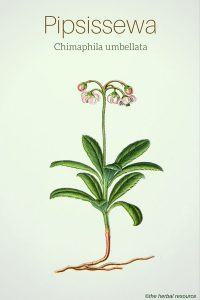Pipsissewa contains quinones (hydroquinones), flavonoids, triterpenes, phenols, methyl salicylate, essential oil, and tannins. Quinones have been proven to have a disinfecting effect on the urinary tract.
Pipsissewa was an important herb among the native Americans in North America, and they used it in the form of herbal teas for a variety of health problems, especially as a tonic and diuretic medication for rheumatism, kidney and bladder ailments. The herb was also popular among the European settlers.
Modern scientific studies have confirmed that the plant can be useful as a diuretic and urinary tract disinfectant.
It was widely used and highly regarded by herbal practitioners in North America as a safe and reliable antiseptic and antibacterial agent for treatment of cystitis, painful urination, bladder and kidney stones, kidney inflammation, prostatitis, gonorrhea and other ailments.
The herb helps the body to get rid of excess fluid and waste products by increasing urinary flow and improve liver function.
Drinking tea made from pipsissewa may be effective as a remedy for rheumatism, arthritis and gout.
Animal studies have shown that extracts of the herb also have the ability to lower high blood glucose values.
Chimaphila umbellata has the same effect on the urinary system as bearberry (Arctostaphylos uva-ursi). Both these plants have hydroquinone as the main active ingredient.
Pipsissewa has a lower content of tannins than bearberry and more diuretic properties which make it more suitable for long-term use.
North American Indians used the plant to increase sweating, to treat fever diseases (like typhoid) and as a fevers reduce agent.
They also used it for painful menstruation and tuberculosis of the lymph glands of the neck.
Pipsissewa is a bitter herb which has been used internally as a tea to treat ailments of the respiratory tract like colds, whooping cough and bronchitis.
Furthermore, it was used as a remedy for lack of appetite and poor digestion.
Externally, an extract of pipsissewa was used as an astringent eyewash for sore eyes. Extracts of the fresh leaves can be used as a wash or wet compresses on the blisters, tumors, ulcers, and swelling.
Fresh plant material can be placed directly on the skin as a painkiller for rheumatism in the joints and muscles.
The leaves have has also been used as a tobacco substitute.
Herbal Resource
Latest posts by Herbal Resource (see all)
- What is Maritime Pine Bark used for? - December 23, 2023

Leave a Reply